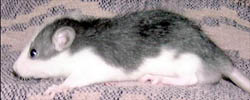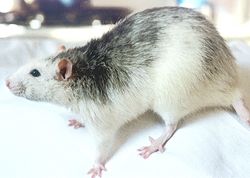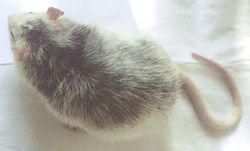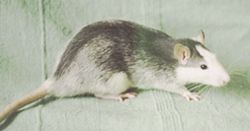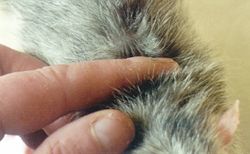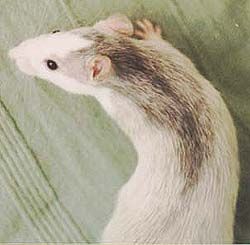Little is known about the early history of the Husky. Some claim they originated in Russia, others say Eastern Europe.
They were first seen in the UK approximately 3-4 years ago, and have been turning up in pet shops from time to time. They are shown at NFRS shows under the name "Roan" and "Striped Roan".
In Europe they are very popular, particularly in Holland, Belgium, Switzerland, Germany and France. At the 2000 Knagerfestijn [Rodent Festival] in Holland, 18 Huskies were on show. Two litter brothers of the winning Best Husky at this show were brought to the UK for breeding, and bred to Huskies we already had, gave all Husky litters, indicating that the Husky we have in the UK is genetically identical to the Husky found in continental Europe.
Most Huskies are black-based, though it is possible to breed other colours. The main problem with developing other shades is that lighter colours bleach out ofter time, leaving a white rat.
All Huskies have a white pattern.
BANDED PATTERN
Banded, also known as Striped, resembles
a Hooded with an extra-wide saddle. When the rat is viewed from the side,
this band is so wide that the rat appears half white and half coloured.
BERKSHIRE PATTERN is usually
similar to Berkshire, with a very large part of the stomach white.
There is also always some kind of facial marking, which may be as small as a star, or as much as an inverted V-shaped blaze.
The babies are born black, (on black-based ones), which fades to a deep "navy" blue, and get their silvering at the first change of coat, completing by 6-7 weeks. It's quite an amazing transformation and happens almost overnight. One minute you have plain black and white rats, the next you have dark blue rats that look like they're wearing a coat of frost or a blanket of rain.
They continue lightening throughout their lives, and vary a lot in the speed of it Some can be very light, heavily-silvered as kittens, and others are dark and barely-silvered as adults. Most adults end up an uneven grizzled dark blue brindle on the top of the head and back only. Many that start life with a full V-shaped blaze end up with the entire face white.
Tail markings are an interesting feature of this variety. Babies in the nest have pied tails, but by 14 weeks the pigment has gone, leaving an unmarked pink tail.
